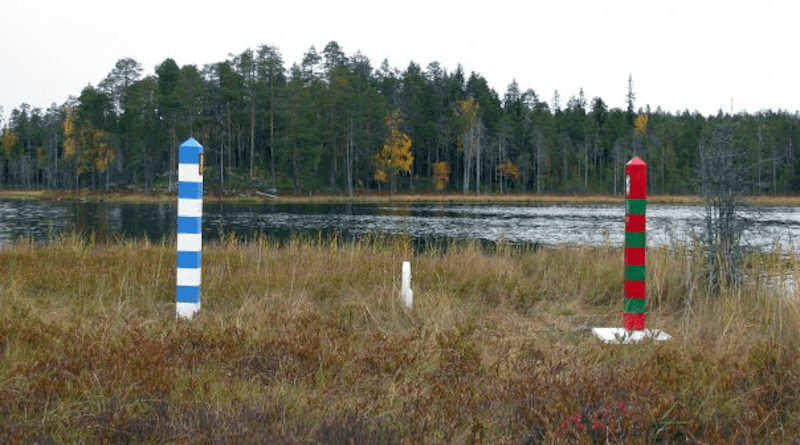Finland’s NATO Accession And The Migration-Security Nexus – Analysis
In recent years, Finland has witnessed a rush in the number of Russian migrants crossing its borders. This influx has sparked concerns among analysts about the potential for these migrants to be used as a tool for launching hybrid warfare by the Kremlin . At the same time, Finland’s decision to bridge NATO has further heightened unease with Russia, leading to accusations of the Kremlin purposely funneling migrants to the border. In light of these developments, it is important to analyze the circumstances objectively and examine the possible implications of these events .
Firstly, it is essential to understand the motivation behind Finland’s decision to join NATO. As mentioned in the literature, this move was a direct response to Russia’s invasion of Ukraine. Finland, along with fellow Nordic country Sweden, had historically preserved a position of military non-alignment. However, the invasion served as a wake-up call for Finland, prompting a shift in their security policy. This outcome reflects a growing concern over Russian aggression, particularly towards its neighboring countries.
On the other hand, Russia has vehemently resisted Finland’s NATO membership, describing it as a ‘meaningless step.’ Russian President Vladimir Putin has also threatened to deploy troops and ‘systems of destruction’ to the Finnish border in retort . These statements only serve to aggravate the already strained relations between the two countries. It is evident that Russia sees Finland’s NATO membership as a threat and is willing to take measures to counter it.
On one hand, the situation cannot be conceived without the inclusion of the Russian migrants going to Finland. The Prime Minister of Finland, Petteri Maeva, has accused Russia of being behind the spread of this disinformation. Indisputably, the Kremlin has negated this matter as a fabrication, but still, it is a legitimate apprehension coming from the Russians´ interference in the neighboring states. In addition, as a matter of fact, due to the numerous occasions past when Russia used hybrid warfare tactics, it would also be suspicious not to consider the possibility that these would be used in the same manner by these migrants to cause unrest and destabilize Finland from within.
It is only natural to state that the Finnish government’s decision to accede to the ranks of NATO allies was dictated by the necessity to ensure the security of the nation’s borders and its sovereignty . Nonetheless, it has been contributing to increasing volatility and mutual antagonism with Russia, and for instance, the help of Russian entities bypassing the border controls in Finland is a recent public concern too . With this trait in mind, it is of great importance to make necessary arrangements to cope with the issue of Russian migrants, as well as to keep an eye on any emerging vague threat that they may pose.
Simply, the position adopted by Sweden toward Russia has been playing a role here. It is no secret to everyone that both Finland and Sweden have announced their ambition to join NATO, and the Kremlin leadership also can see it very well. Russia distinguished itself by claiming that the recent sanctions were a hostile move and even threatened to provoke a serious response like ‘political and military-technical countermeasures.’ This most of all reminds us about the dark sides of the escalating Russia-US conflict .
Securitization of Finland’s Relationship with Russia
The concept of securitization refers to the process of framing an issue as a security threat and taking extraordinary measures to address it (Buzan, Wæver, & de Wilde, 1998). In the context of Finland joining NATO, the issue has been framed as a security threat to the country’s relationship with Russia . This is due to the long-standing history of Finland as a neutral country and its policy of maintaining good relations with its neighbor, Russia.
Finland’s decision to join NATO is seen by many as a strategic move to ensure its security in the face of an increasingly assertive Russia. The 2014 annexation of Crimea by Russia and its involvement in the conflict in Ukraine have raised concerns about the Kremlin’s intentions in the region . As a country with a long history of being under Russian influence, Finland has been wary of any actions that could lead to a deterioration of its relationship with Russia. Therefore, the decision to join NATO has been seen as a step towards securing its sovereignty and deterring any potential Russian aggression.
Conclusion
The situation in Finland presents a complex and delicate balance between national security and maintaining good relations with its neighbor, Russia. The decision to join NATO has been met with resistance and threats from the Kremlin, which sees this as a direct threat to its security interests. The influx of Russian migrants has further added to the already tense situation. Finland must carefully navigate this situation, ensuring the safety and security of its citizens while keeping the door open for diplomatic solutions to ease tensions with Russia

